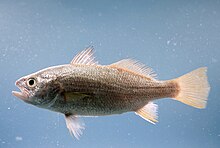Bairdiella is a genus of marine ray-finned fishes belonging to the family Sciaenidae, the drums and croakers. These fishes are found in the western Atlantic and eastern Pacific Ocean.
| Bairdiella | |
|---|---|

| |
| Bairdiella chrysoura | |
| Scientific classification | |
| Domain: | Eukaryota |
| Kingdom: | Animalia |
| Phylum: | Chordata |
| Class: | Actinopterygii |
| Order: | Acanthuriformes |
| Family: | Sciaenidae |
| Genus: | Bairdiella Gill, 1861 |
| Type species | |
| Bodianus argyroleucus | |
| Synonyms[1] | |
Taxonomy
editBairdiella was first proposed as a monospecific genus in 1815 by the American biologist Theodore Gill with Bodianus argyroleucus, a species described in 1815 by Samuel L. Mitchill from New York, as its only species.[1][2] Mitchill's B. argryleucus was later shown to be a synonym of Dipterodon chrysourus which had been described by Bernard Germain de Lacépède in 1802 from "Carolina".[2] Bairdiella belongs to the family Sciaenidae in the order Acanthuriformes.[3] Some authorities place Bairdiella in the subfamily Stelliferinae[4] but subfamilies are not recognised within Sciaenidae by Fishes of the World.[3]
Etymology
editBairdiella suffixes the surname Baird with the diminutive -iella, Gill did not explain whom he was honoring with the name but it is most likely to be Spencer Fullerton Baird, the director of the United States National Museum where Gill worked.[5]
Species
editThere are currently seven recognized species in this genus:[6]
- Bairdiella armata Gill, 1863 – armed croaker
- Bairdiella chrysoura (Lacépède, 1802) – silver perch
- Bairdiella ensifera (Jordan & Gilbert, 1882) – swordspine croaker
- Bairdiella goeldi Marceniuk, Molina, Caires, Rotundo, Wosiacki & Oliveira, 2019[2]
- Bairdiella icistia (Jordan & Gilbert, 1882) – ronco croaker
- Bairdiella ronchus (Cuvier, 1830) – ground croaker
- Bairdiella veraecrucis Jordan & Dickerson, 1908[2]
Characteristics
editBairdiella is a genus of relatively small Sciaenids.[7] They have an elongate, compressed body with a slender head and a short, blunt snout. There are no barbels on the chin but there are mental pores. The large mouth is slightly oblique and extends back as far as the posterior edge of the orbit. The teeth are conical and arranged in thin rows. The upper angle of the gill slit is notched and the preoperculum is serrated with large spines at its angle. There is a deep incision in the dorsal fin between the spines and the soft rays. There are 2 spins and between 8 and 10 soft rays in the anal fin. The caudal fin is rounded and blunt or angular and blunt with the lateral line reaching the center of the caudal fin. Almost all of the scales are ctenoid.[8] These croakers have maximum published total lengths of 30 to 35 cm (12 to 14 in).[6]
Distribution and habitat
editBairdiella croakers are coastal fishes from the eastern Pacific Ocean and western Atlantic Ocean.[6]
References
edit- ^ a b c Eschmeyer, William N.; Fricke, Ron & van der Laan, Richard (eds.). "Genera in the family Sciaenidae". Catalog of Fishes. California Academy of Sciences. Retrieved 23 April 2023.
- ^ a b c d Eschmeyer, William N.; Fricke, Ron & van der Laan, Richard (eds.). "Species in the genus Bairdiella". Catalog of Fishes. California Academy of Sciences. Retrieved 24 April 2023.
- ^ a b J. S. Nelson; T. C. Grande; M. V. H. Wilson (2016). Fishes of the World (5th ed.). Wiley. pp. 497–502. ISBN 978-1-118-34233-6. Archived from the original on 2019-04-08. Retrieved 2023-04-24.
- ^ Tárcia Fernanda da Silva; Horacio Schneider; Iracilda Sampaio; et al. (2018). "Phylogeny of the subfamily Stelliferinae suggests speciation in Ophioscion Gill, 1863 (Sciaenidae: Perciformes) in the western South Atlantic". Molecular Phylogenetics and Evolution. 125: 51–61. Bibcode:2018MolPE.125...51S. doi:10.1016/j.ympev.2018.03.025. ISSN 1055-7903. PMID 29567506.
- ^ Christopher Scharpf & Kenneth J. Lazara, eds. (9 March 2023). "Series Eupercaria (Incertae sedis): Families Callanthidae, Centrogenyidae, Dinopercidae, Emmelichthyidae, Malacanthidae, Monodactylidae, Moronidae, Parascorpididae, Sciaenidae and Sillagidae". The ETYFish Project Fish Name Etymology Database. Christopher Scharpf and Kenneth J. Lazara. Retrieved 24 April 2023.
- ^ a b c Froese, Rainer; Pauly, Daniel (eds.). "Species in genus Bairdiella". FishBase. February 2023 version.
- ^ Alexandre Pires Marceniuk; Eduardo Garcia Molina; Rodrigo Antunes Caires; Matheus Marcos Rotundo; Wolmar Benjamin Wosiacki; Claudio Oliveira (2019). "Revision of Bairdiella (Sciaenidae: Perciformes) from the western South Atlantic, with insights into its diversity and biogeography". Neotropical Ichthyology. 17 (1): e180024. doi:10.1590/1982-0224-20180024. hdl:11449/185670.
- ^ "Genus: Bairdiella, Striped Croaker, Croakers". Shorefishes of the Greater Caribbean online information system. Smithsonian Tropical Research Institute. Retrieved 24 April 2023.